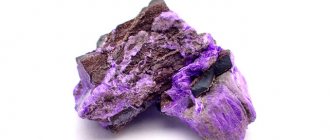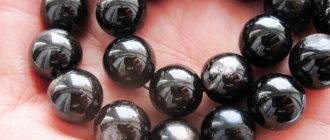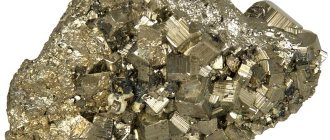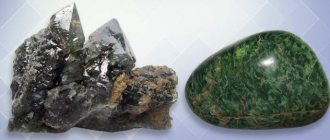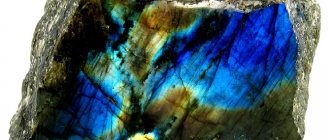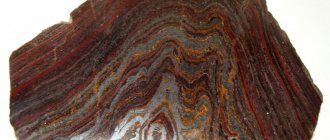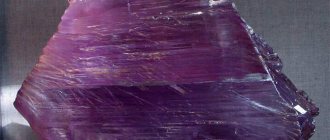| Category | Quartz |
| Title in English | Praziolite |
| Formula | SiO2 |
| Group | Quartz group |
| Color | Onion green |
| Stroke color | White |
| Shine | Glass |
| Transparency | Transparent, Translucent |
| singonia | Trigonal |
| Hardness | 7 |
| Cleavage | Absent |
| Density, g/cm³ | 2,65 |
| Kink | Conchoidal, Fragile |
| origin of name | “Onion stone” or prasiolite. The person who came up with the name for this mineral clearly has a wonderful imagination. By the way, the first mentions of prasiolite appear in the times of Ancient Greece. The word “prasio” or πράσιος itself is translated from ancient Greek as the color of leek (light green). This interesting resemblance is due to the color of the stone, which resembles the color of a leek. |
Prasiolite is a natural variety of crystalline quartz. This mineral is rare and comes in rich green tones: emerald and onion green, lemon and grassy. Prasiolite is characterized by increased fragility, translucency, glass luster and conchoidal fracture. Under the influence of sunlight, the gem loses its color and turns into rock crystal.
Prasiolite deposits
The first deposits of prasiolite were discovered in Switzerland. To date, its deposits have been found in Brazil, Australia, India, Madagascar, South Africa, and Uruguay. Small mines are developed in Poland, Germany, America, and Russia. Almost all modern mineral deposits have been worked out, and specimens of natural prasiolite are very rare.
History of prasiolite
— Advertising —
The term “prasiolite” is translated from Greek as “onion stone”. This name is associated with its hexagonal prismatic crystals, as well as its soft green color, reminiscent of leeks. It was in Ancient Greece that prasiolite was first discovered two thousand years ago. And the Greeks also noticed that in the bright sun its crystals become pale. This phenomenon was explained by the influence of the Gods.
Initially, the name of the mineral sounded like “prasitis”, and only in the middle of the 20th century it was transformed into the modern “prasiolite” and a scientific description was given to the stone. Since natural deposits of this stone are almost completely exhausted today, there are methods for producing artificial prasiolite by calcining amethysts at a temperature of 5000°C.
General description of the stone
Prasiolite is a type of quartz. It got its name thanks to the color. Formed by two ancient Greek words: the first is translated as “light green” or “leek”, the second is “stone”. There are different shades.
The stone is rarely found in nature. Most of the “prasiolites” that go on sale are synthetic crystals or fakes. Sometimes the mineral is also called green amethyst. In fact, these are different stones. A beautiful name helps you sell better.
Synthetic prasiolites are made from amethysts. The stones have a similar structure. When heated strongly, some amethysts take on an onion-like color. Yellowish quartz is also processed. The technology was first tried in 1950 in Brazil.
Main properties of prasiolite:
- transparency - full or partial;
- strength - 7 points on the Mohs scale;
- refraction of light - low;
- shine - dim;
- In the sun, the mineral gradually fades.
Prasiolite stone is easy to cut and polish. Together with its beauty, this makes it a convenient material for jewelry: pendants, necklaces, earrings and more. Sometimes prasiolite is used to imitate more expensive stones. It looks like peridot, tourmaline, beryl.
Prasiolite is mainly used in jewelry. The stone is considered semi-precious and ornamental.
Prasiolite stone (video)
Afraid of the sun
Prasiolite has been produced by calcining mined amethysts since 1950. This requires a temperature of 500 degrees Celsius. Therefore, almost all jewelry that lies on jewelry counters are heat-treated minerals. Most of them are mined in Brazil in the Montezuma mine or in the US state of Arizona.
However, those stones that were obtained by heating and calcination are afraid of sunlight. They fade. The rich bright green color of prasiolite indicates heat treatment and that this is a green amethyst.
If when purchasing you see a light green tint, then you can’t hope that the stone is natural. The number of prasiolites in the world is so limited that it is hardly possible to find it on the open market. Some gemologists generally believe that there is no natural prasiolite.
Where does color come from?
Classic amethysts owe their purple-pink hue to impurities of manganese and iron. Green color in nature is created by pigments of organic origin.
Green amethyst
But this rarely happens, so people have learned to create green amethysts. They are obtained by irradiation or calcination of quartz or amethysts of other colors. Stones from the Brazilian Montezuma deposit or Arizona (USA) are used.
At temperatures up to +500 °C, the final color of amethyst turns out to be onion or light green, lemon yellow, or emerald.
This depends on the chemical composition of the raw materials and the characteristics of the procedure. The resulting material is also called prasiolite or green amethyst.
Types of prasiolite
— Advertising —
Natural prasiolites are very different from each other in color. There are samples with an onion tint, and there are also greenish-yellow ones. In general, the mineral is classified by color into:
- Light green;
- Emerald;
- Rich green;
- Citric;
— Advertising —
- Colorless.
The magical properties of prasiolite
Since ancient times, prasiolite, as a type of quartz, was considered part of the astral shell of our planet, and its crystals were a source of preserved signals from the Universe.
Prasiolite was also considered a stone of illusion, and was used for magical purposes by experienced magicians. It was believed that the gem was capable of stupefying and confusing an ignorant person and making what he wanted real. In general, prasiolite has a positive effect on humans.
It develops mental activity, speech and imagination, strengthens memory. In frames made of silver and platinum, its similar properties increase many times. Such an amulet will attract good luck, success and prosperity in financial matters, and will help you find true and sincere love. Prasiolite amulets protect their owners from bad thoughts and actions.
Astrology and magic
Experienced fortune tellers and psychics use this mineral to recognize riddles.
It facilitates the process of perceiving surrounding events. Ancestors believed that prasiolite absorbed signals emanating from the Universe. Inexperienced owners are not always able to recognize information coming from outside.
Prasiolite is used to create a positive emotional background. The person who wears this stone is protected from slander, the evil eye and troubles. The effect is enhanced by combining the green variety of quartz with silver. The stone is suitable for representatives of all zodiac signs. The effect is expressed in different ways:
- Aries – saving vitality, strengthening status, faster career growth;
- Taurus – success in any business;
- Gemini – improved relationships with people;
- cancer – strengthening family and friendly ties;
- Leo – protection from mental torment, self-confidence;
- Virgo – more active self-expression, disclosure of all available possibilities;
- Libra – neutralization of negative energy, prevention of depression;
- Scorpio – stabilization of the balance of vital forces, activation of reserves;
- Sagittarius – facilitating choice, sharpening intuition;
- Capricorn – attracting new people, normalizing the emotional state;
- Aquarius - character becomes more solid;
- Pisces - reducing the risk of depression, imparting firmness and determination.
The decoration connects the owner with a guardian angel. To attract good luck and success, prasiolite is framed in a silver frame.
The healing properties of prasiolite
In lithotherapy, it is recommended to infuse water with prasiolite and then use it as an adjuvant in the treatment of many diseases: normalization of the heart and blood vessels, restoration of the nervous system and general tone of the body.
Such water has a positive effect on the human psyche, gives peace, constancy and regularity, and relieves sudden mood swings. In addition, it is also used in cosmetology. It is believed that when washed daily with prasiolite water, the skin becomes soft, clean and velvety.
Prasiolite is used in the treatment of colds and respiratory diseases. It strengthens the immune system, improves memory, helps develop logic and imagination.
Branches of application of prasiolite
As a rare jewelry stone, prasiolite is constantly in demand and is one of the most expensive minerals. Prasiolite inserts look beautiful in rings, bracelets, pendants, and earrings. Thanks to the fact that technologies for its synthetic production have been developed today, jewelry with prasiolites is quite common on the market.
Medical significance of the mineral
In addition to its magical properties, prasiolite also has a very useful medical healing effect. The work of the mineral in this direction, first of all, is to restore the activity of vital organs in the human body. Some therapists, who do not exclude the possibility of treatment with traditional methods, are convinced that regular intake of water infused with this stone has a positive effect on human health in general. If the liquid is also filtered, it will help regulate the functioning of the cardiovascular and nervous systems, restore normal metabolism and other metabolic reactions, as well as ensure the necessary energy balance.
A talisman or decoration with prasiolite charges a person with inner peace, protects him from stress and other mental disorders, at least in the initial stages.
Water charged with the positive energy of the mineral is effectively used in cosmetology. Various massage products and body lotions are made on its basis. If you wash your face with only this liquid every day, you can get very good results. In this case, the skin will get rid of rashes, spots and peeling, and will acquire a healthy shine and color.
It’s difficult to explain, but prasiolite can alleviate colds, infectious diseases, and also eliminate headaches. It has a beneficial effect on the immune system, so if you carry such a stone with you, you can be sure that illnesses will bother you much less often.
Artificial prasiolite
The method for producing synthetic prasiolite is simple: for this, yellowish or violet quartz is heated to a temperature of 5,000 °C.
At the same time, their color changes to green. Even craftsmen in the Urals used a similar method when they baked quartz in loaves of bread and as a result received crystals of pure green color. Residents of India calcined quartz using focused sunlight, for which they even came up with special devices made from lenses and mirrors. It is very difficult to distinguish artificial samples from natural stones even for a specialist. And the only significant difference between them is that the synthetic mineral does not lose color in sunlight.
Deposits and physical properties
What is this stone? The chemical form of the gem is SiO2. It is common to all quartz materials. The stone is not distinguished by luminescent characteristics or the effect of pleochroism. This means that viewing the crystal under different lighting does not change the shade.
Natural stone can be transparent or translucent. According to the Mohs scale, hardness is 7 points. At the same time, the gem is considered fragile. Its properties are comparable to beryl or peridot.
Natural prasiolite is rare. There are several deposits on Earth in which it is mined industrially. They are located in the following countries:
- India. In this country, luxury stones are mined, which have a magical play of different variations of green.
- Brazil. The stones mined in this country are characterized by a strict light green color.
- USA. The largest crystals are mined in this country.
- Russia. In the Primorsky Territory, beautiful crystals are mined, which are characterized by the correct shape. In terms of variety of colors, they are comparable to Indian gems.
According to jewelers, finding natural stones on sale can be very problematic. Crystal deposits are too scarce. Moreover, scientists have long developed a method for producing artificial gems.
To do this, take tsetrin or amethyst and expose it to high temperatures of 5000 degrees Celsius. After which the minerals are exposed to ultraviolet light. As a result, it is possible to obtain a real stone that has the original physical characteristics. It is important to consider that it does not have medicinal or magical properties.
How to care for prasiolite
Jewelry with prasiolites cannot be worn constantly without taking it off; it is necessary to give the stone the opportunity to remove negative energy.
It is also not recommended to give this stone to other people - they always buy a new product as a gift. With prolonged exposure to sunlight, natural prasiolite loses its color, so jewelry made from it is stored in tightly closed boxes, wrapped in dark cloth.
To clean them, use cool running water and a soft cloth. The use of chemical cleaning agents is not recommended.
The first mention and history of the origin of the mineral
Prasiolite stone was used by the ancient Greeks already 2.5 thousand years ago to create unique jewelry.
At that time, it was called “onion stone”, because after losing its bright color under the influence of temperatures, it became similar to a leek. During the Middle Ages, it was believed that prasiolite had the ability to endow the owner with wisdom and insight. This belief still exists today.
One of the most famous jewelry with the mineral is the brooch of Catherine II, which was given to her by the Polish king Stanislaw II August Poniatowski . Moreover, the Russian Empress really liked the jewelry, and she wore it all her life, believing that it was this gem that allowed her to achieve success in wars and become Great.
Prasiolite and zodiac sign
Prasiolite personifies sincerity, sincerity and peace - qualities that are inherent in representatives of such zodiac signs as Pisces, Aries, Sagittarius and Aquarius.
For this reason, it is recommended for them by astrologers. The stone eliminates anxiety, fear and troubles, especially if it was given by a loved one. There are no contraindications for the use of prasiolite for other zodiac signs. The main thing is to correctly assess the interaction between a person and a stone.
Prices for prasiolite products
Jewelry with natural prasiolite is extremely rare; it is literally rare and only a few manufacturers around the world work with it.
Transparent faceted prasiolite is valued at $20 to $100 per carat. The price of the finished product is influenced by the quality and size of the stone, the type and material of the frame. However, in almost every jewelry store you can find a ring, earrings, bracelet or pendant with a synthetic stone, which is no different in appearance from a natural one, but at a much lower cost. Artificial prasiolite is valued at $5 to $10 per carat. It is also set in gold and silver frames and such jewelry looks very impressive.
How to distinguish from a fake?
Ring with prasiolite stone
Real prasiolite can be found very rarely in jewelry stores. In most cases, the buyer is offered an artificially created gem, which is almost impossible to distinguish from a natural mineral. The certificate accompanying such a stone must indicate this information, as well as what mineral was used to create it.
The main features that can distinguish prasiolite from a fake are:
- pallor of shades;
- absence of cloudy areas in the structure of the stone;
- natural inclusions in the structure, crystal shape;
- natural heaviness and coolness of the mineral.
Interesting facts about prasiolite
- In the artificial production of prasiolite, even cloudy quartz crystals with uneven color are used. After calcination, all defects are eliminated and as a result the stone becomes clean and beautiful. Natural prasiolites have practically not been found on the jewelry market for the last half century; they have been completely replaced by an artificial substitute. This is due to the fact that the production of prasiolites in industry is not expensive and economically profitable.
- It is popularly believed that if the owner of prasiolite often lies, the stone will quickly become dull and discolored.
Loses color in the sun
But the prasiolite stone was known long before the beautiful legend appeared. This is evidenced by the ancient Greek root, which is the basis of the name of the stone. True, then it was called prasitis - a word that has the same basis and literally means the color of young leeks, the color of fresh greens.
It turns out that two thousand years ago people were already making jewelry from this stone. The comparison with onions is not accidental, since the green mineral almost always has a pure color, without serious inclusions of any other pigments. Under prolonged exposure to the sun, prasiolite loses its saturation, the green color lightens to yellow.
Some gemologists considered the mineral to be green amethyst, since many of the stones' characteristics are similar. This name is used as a trade term for prasiolite.
